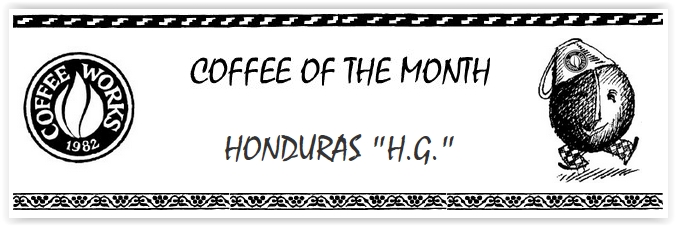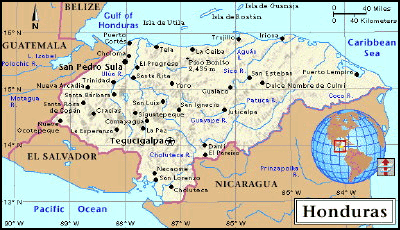Honduras H.G.

MUCHO GUSTO
Mention Honduras and the mind conjures up a jumble of non-coffee associations: Tropical rain forests, Sandy beaches, Mayan ruins, Bananas, Panthers, Contras, Crocodiles, Cigars, and, as one tourist brochure poetically puts it, a land still dreaming under the spell of its own natural beauty.
Honduras is almost wholly mountainous, with narrow coastal plains. Two major mountain ranges running east to west divide the nation into halves. It is a republic bordering on Guatemala and El Salvador on the west and Nicaragua on the south and has both a Caribbean and a Pacific coast. The rugged terrain has limited the transportation network and kept the population of five million predominately rural and isolated. (Two out of the three railroads are owned by the banana companies, and all run along the north coast.)
Ninety percent of the population are mestizos (people of mixed European and Indian descent), while Indians (7%) live in the west near the Guatemala border, and most blacks (2%) live on the Caribbean coast. The capital city is Tegucigalpa {tay-goo-see-gahl’-pah}, meaning “Silver Mountain” in the language of the native Nahuatl indians. “Tegus” was founded in the 1570’s as a silver- and gold-mining camp on the banks of the Choluteca river at 975 m (3,200 ft) above sea level.
 Honduras was once part of the Maya empire, which flourished from about AD 250 to 950, and the ruins of this advanced civilization can still be seen at Copan (a modern coffee-growing region). Christopher Columbus reached the Honduran coast in 1502. Hondurans declared independence from Spain in 1821.
Honduras was once part of the Maya empire, which flourished from about AD 250 to 950, and the ruins of this advanced civilization can still be seen at Copan (a modern coffee-growing region). Christopher Columbus reached the Honduran coast in 1502. Hondurans declared independence from Spain in 1821.
While virtually unknown as a specialty coffee producer, Honduras was the tenth largest supplier of coffee to the US last year. Efforts are being made to market “Honduran Star Mountain” as a premium brand, but we haven’t seen any offers. Due to transport limitations, all Honduran coffee is shipped from Puerto Cortes on the Caribbean coast. This has helped to supress its exposure among Pacific coast roasters, although some Guatemalan has always included cross-border coffee from Honduras. The current trend is toward greater differentiation in quality and price.
From our recent run of super-premium Coffees of the Month we may at times have seemed to be endorsing that trend. However, while we do believe that higher quality deserves higher reward, there are still many fine coffees that do not carry a super premium price. Honduran, which bears a simple “H.G.” grading, meaning High Grown washed Arabica, is one example.
The quality is in the cup, not on the label. It is a delicious example of a humble Central American coffee; Lighter in body and complexity than a Sumatra, with none of the ferocious acidity of an East African, yet possessing a charmingly clean-tasting balance of lean body, smoky aroma, and high spirit. Mucho gusto.


